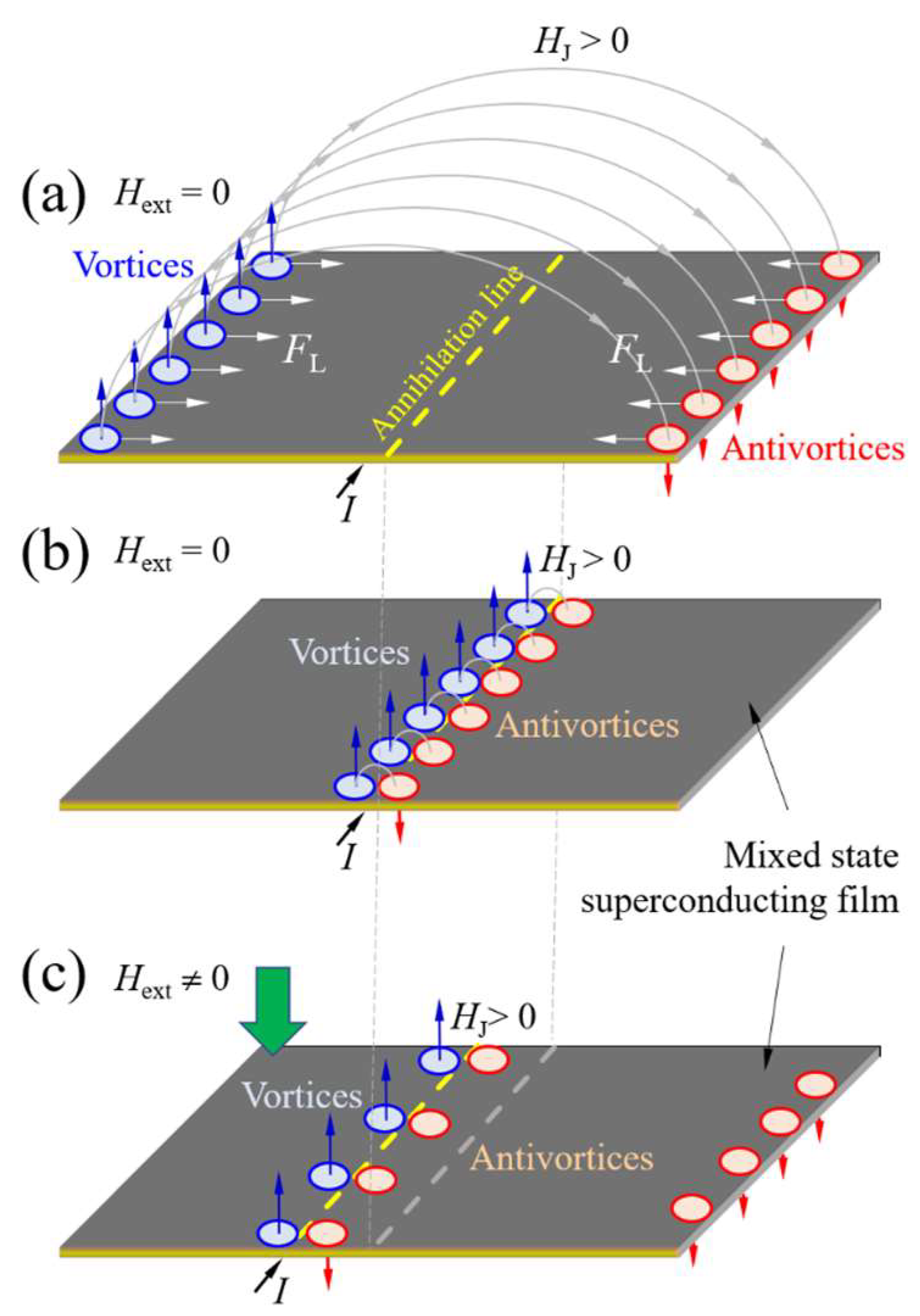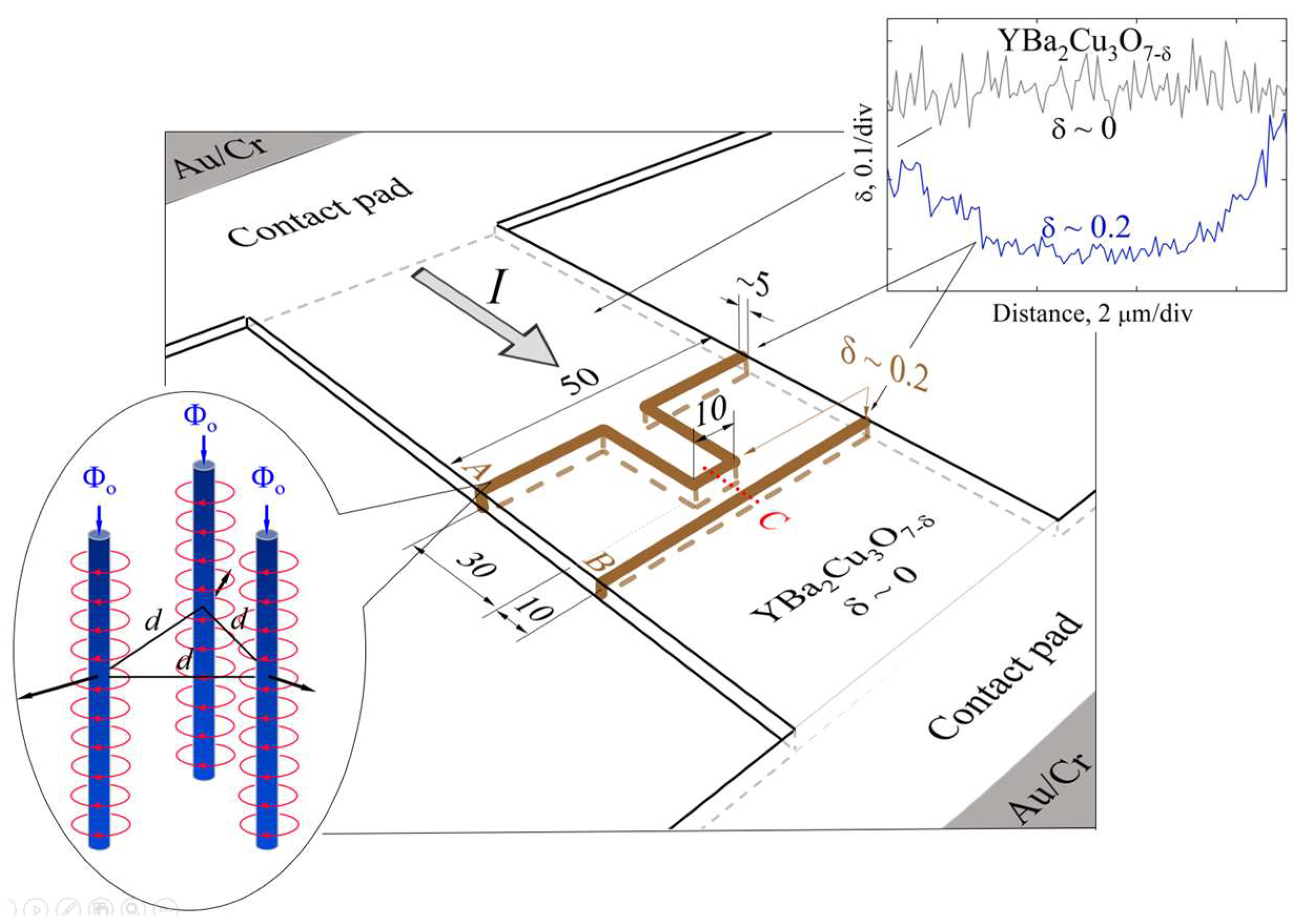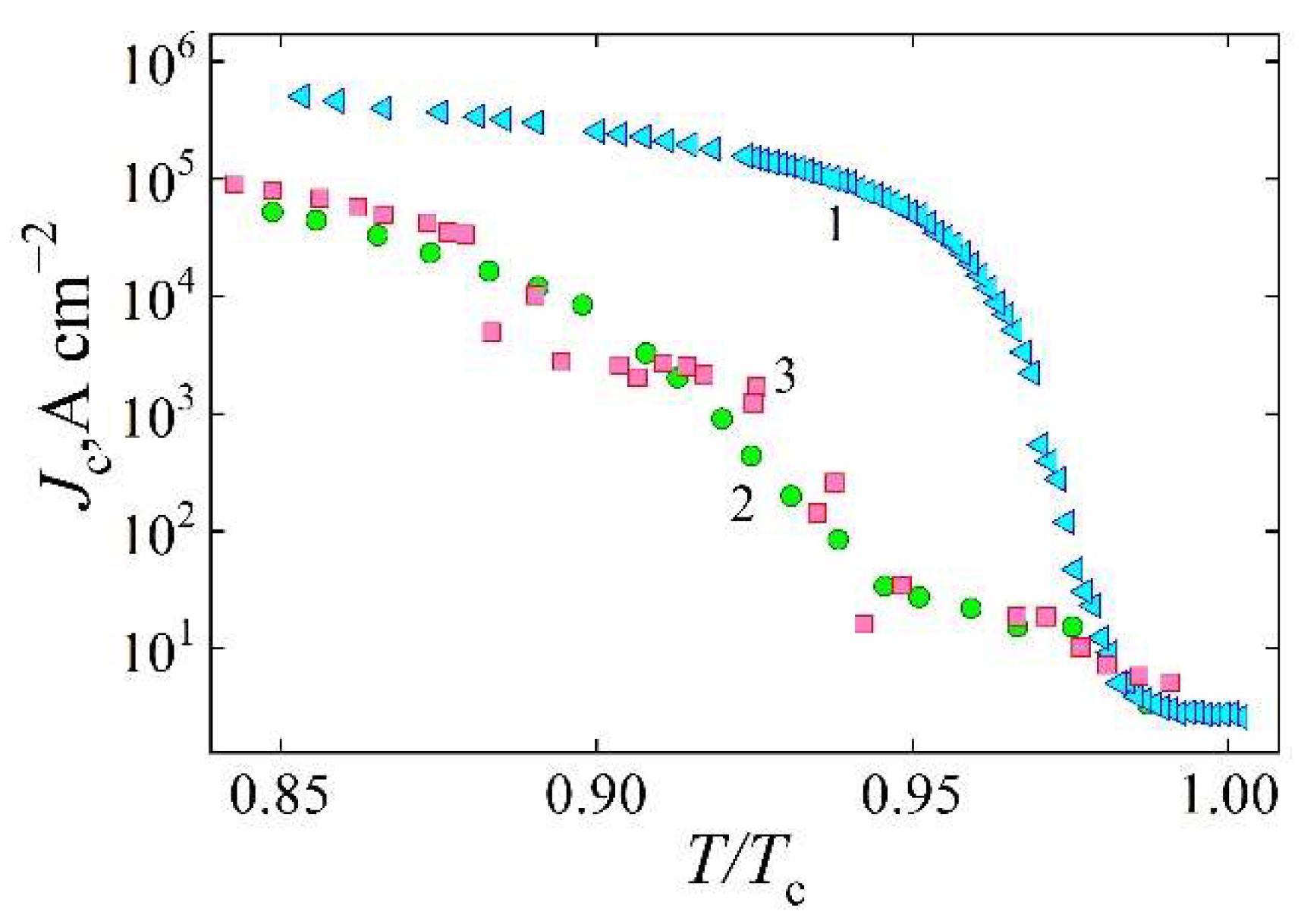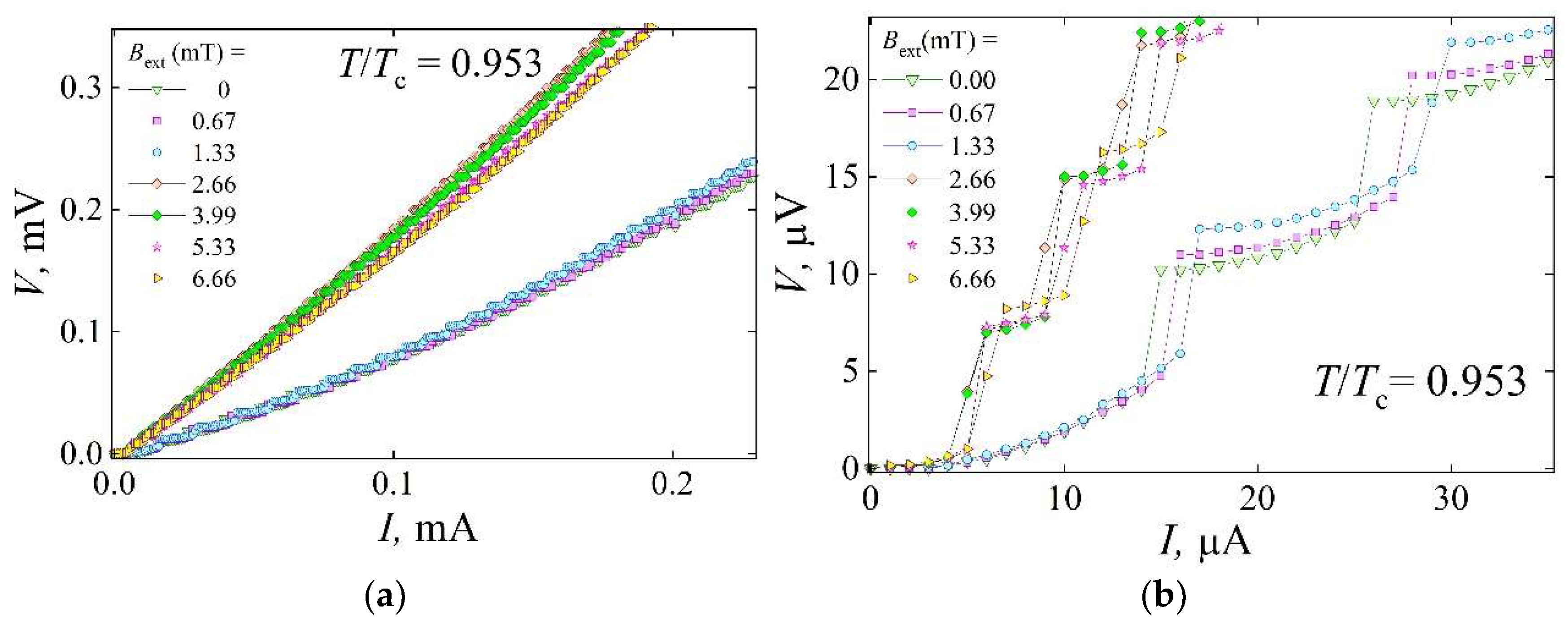1. Introduction
The motion of Abrikosov magnetic vortices, as circular currents enclosing a magnetic field line that carries a single flux quantum Φ
0 =
h·(2
e)
−1 = 2.068 × 10
−15 Wb, and antivortices, characterized by oppositely directed magnetic field lines, leads to energy dissipation in type II superconducting films biased with a supercritical current density
Jc. Here,
h = 6.626 × 10
−34 J⋅s is the Planck constant and
e = 1.602 × 10
−19 C is the electron charge [
1,
2]. The dissipation process manifests experimentally as a finite resistivity in the mixed state of the superconductor and can be divided into several stages: condensation of vortices/antivortices at opposite edges of the superconducting film at a magnetic field
HJ ≥
Hc1, their nucleation and motion toward the center of the film due to the action of the current’s self-produced Lorentz force,
FL, and their annihilation at the center of the film with antivortices. Here,
Hc1 is the critical field at which magnetic flux begins to penetrate the superconductor in the form of Abrikosov vortices. At the moment of vortex–antivortex annihilation, a new pair is instantaneously generated. Under constant bias current conditions, corresponding to a fixed-current self-induced magnetic field
HJ, the number of vortex–antivortex pairs
n remains constant and is described by the following relation [
1]:
where μ
0 = 4π × 10
−7 H·m
−1 is the magnetic permeability of free space, and μ is the effective magnetic permeability of the superconducting material in the mixed state.
The Lorentz force,
FL, arising from the self-induced crossed electric and magnetic fields due to the bias current, initiates the nucleation and subsequent acceleration of the magnetic flux (
Figure 1). The rate of flux nucleation is determined by the amplitude of the pinning force,
Fp, originating from imperfections in the crystalline structure of the superconductor, e.g., one-, two-, and three-dimensional defects, such as impurities, inhomogeneities, and dislocations [
3]. The resulting flux flow velocity,
v, is inversely proportional to the effective viscosity η of the superconducting medium, which impedes vortex motion. This relationship is described [
4] by:
where
Fp is lower than
FL for the flux flow to occur.
When the pinning force exceeds the Lorentz force (
Fp >
FL), the magnetic flux lines remain pinned and no vortex motion occurs (
Figure 1a). The pinning force is directly related to the spatial variation in the vortex condensation energy [
1,
2,
3,
4,
5]. These variations arise from differences between regions of weak and strong superconductivity [
5], where the latter are typically characterized by a higher critical temperature
Tc, critical current density
Jc, and lower critical magnetic field
Hc1. Here,
Tc is the maximum temperature at which the material remains superconducting, while
Jc denotes the maximum current density that a type II superconductor can carry without inducing vortex motion. Under such conditions, only isolated vortex nucleation may occur, corresponding to the regime of thermally activated flux flow (TAFF).
As the applied current increases, the density of magnetic flux lines increases, leading to enhanced mutual repulsion because of their associated magnetic fields. This interaction facilitates the nucleation of additional vortices and results in energy dissipation as the vortices begin to move through the superconducting material. This behavior is interpreted as an effective reduction in the pinning force, since the pinning now acts on vortex bundles rather than isolated vortices. The balance between the Lorentz force and the collective pinning force of these bundles governs their dynamics. The motion of vortex bundles manifests itself as a sudden increase in energy dissipation, marking the onset of the flux creep (FC) regime [
2].
In wide thin films, vortices nucleate at random locations along the edges, and their velocity is governed by intrinsic pinning within irregularly formed propagation pathways throughout the film. These pathways can be artificially controlled by selectively modifying the pinning strength in terms of modulating the film thickness [
6] or patterning multilayer structures [
7], modulating the film composition, or introducing defects, such as oxygen vacancies in cuprate superconductors [
8], etc. It was recently shown [
7] that comparatively strong pinning centers can be introduced in YBaCuO
7-δ superconducting films (
Tc~92 K) using a laser-writing technique [
9]. Light absorption by the YBa
2Cu
3O
7-δ (YBCO) superconducting film results in an increase in the temperature of the illuminated areas and outflow of oxygen, producing oxygen vacancies. The appearance of oxygen vacancies causes a decrease in the
Tc,
Jc, and
Hc1 of the superconductor [
10]. If δ exceeds 0.6, a material with an orthorhombic crystalline structure becomes an insulator with a tetragonal crystalline structure [
11] and does not superconduct. However, in sites characterized by δ < 0.6, the superconductor has superconducting properties [
7,
8], showing lower values of
Tc,
Jc, and
Hc1 compared to sites that are rich in oxygen.
By engineering narrow, oxygen-deficient rectangular structures spaced several tens of micrometers apart, additional intrinsic pinning sites for magnetic flux can be introduced [
7]. The sections of the structure aligned parallel to the bias current inhibit the formation of a vortex–antivortex annihilation zone in the center of the film, thus simultaneously restricting vortex motion along the segments perpendicular to the current. At current densities
J >>
Jc, vortices pinned along segments parallel to the current become unpinned and move individually along perpendicular sections (TAFF regime). As the current density increases, strong repulsion between vortices pinned at the edges of the parallel segments leads to the collective unpinning and motion of vortex bundles, resulting in energy dissipation characteristic of the FC regime. This vortex dynamic manifests as voltage steps in the current–voltage characteristics of superconducting thin-film devices, containing partially deoxygenated rectangular structures. These steps provide a useful means for studying vortex behavior under an external magnetic field
Hext applied perpendicular to the film surface.
The current study shows that the application of
Hext creates an asymmetry in vortex and antivortex distributions, shifting the annihilation line toward areas of lower flux density (
Figure 1c). Oxygen-deficient segments, aligned with the direction of current flow, act as barriers to vortex motion and improve the net pinning force by preventing vortex–antivortex pairs from reaching their annihilation zone. The results obtained can help to understand the role of an external magnetic field in controlling the pinning force within YBCO thin films provided with laser-written, rectangular-shaped oxygen-deficient structures. Moreover, since these engineered features are intended to suppress undesirable vortex dynamics, they can compromise the stability and performance of superconducting devices based on type II superconductors.
2. Sample Technology and Measurement Setup
Six YBCO devices, each with dimensions of 50 × 100 μm
2, and two contact pads measuring 1.5 × 1.5 mm
2 were laser-patterned in a nitrogen atmosphere from a 0.3 μm thick YBCO film. The film, with its
c-axis oriented perpendicular to the substrate surface, was deposited on LaAlO
3 substrates using a metalorganic chemical vapor deposition (MOCVD) method. Patterning was carried out using a 532 nm laser beam with an approximate diameter of 5 μ, operating at a power of 2.3–2.5 W and a scanning speed of 5 μm/s. Partial oxygen depletion (δ ≤ 0.2) in rectangular and straight-line structures (indicated by brown lines in
Figure 2) was achieved in a subsequent laser-writing step using the same wavelength, but with a reduced power of approximately 0.4–0.6 W and an increased scanning speed of 50 μm/s.
As shown in
Figure 2 (right inset), the laser-writing technique, which employs a Gaussian-shaped laser beam, produces sloped edges in the oxygen-depleted regions, creating a gradient in oxygen concentration. These sloped regions act as strong pinning centers, where Abrikosov vortices become trapped and interact magnetically with vortices traversing the 10 μm long central part of the rectangular structure [
7]. Under the experimental conditions, magnetic flux penetrates the superconducting film exclusively in these regions (see
Figure 2 (left inset)), forming Abrikosov magnetic vortices and antivortices. To more accurately assess the effect of laser modification on the electrical and magnetic properties, this study used a reference sample from the same YBCO film without laser-written structures and characterized it.
2.1. Technology of an Oxygen-Deficient Structure
When laser light interacts with the YBCO material in an oxygen-free ambient environment, it locally heats the illuminated areas and activates the diffusion of atomic oxygen from hotter to cooler areas. At higher laser powers (2.3–2.5 W), the oxygen content is significantly reduced, with the oxygen deficiency parameter reaching δ ≥ 0.6. Under these conditions, the temperature at the illuminated sites is estimated to reach or exceed 970 K, which corresponds to the orthorhombic to tetragonal phase transition of YBCO [
11,
12]. At such elevated temperatures and with a reduced oxygen content, the material becomes insulating and loses its superconducting properties. This degree of deoxygenation is achieved during the device patterning process, ensuring electrical isolation between devices and eliminating interference throughout the investigated temperature range.
At lower temperatures, corresponding to lower power (0.3–0.6 W), the diffusion of oxygen becomes significantly less pronounced. In YBCO crystals, oxygen diffusion occurs much more rapidly along the
a-b planes than along the
c-axis, by several orders of magnitude [
13]. This anisotropy also affects the oxygen transport dynamics in the YBCO films used in this work, which were fabricated using the MOCVD method. In these films, the
c-axis is oriented perpendicular to the substrate surface, effectively suppressing oxygen diffusion in that direction. Consequently, oxygen diffusion predominantly occurs parallel to the substrate, i.e., within the
a-b planes. However, when nearby oxygen vacancy sites are fully occupied, atomic oxygen can only migrate toward the film surface, resulting in the formation of oxygen concentration gradients along the edges of the laser-modified regions. The steepness of these gradients also depends on the homogeneity of the film and the type and density of structural defects [
13,
14]. In particular, screw dislocations, commonly found in YBCO films grown by the MOCVD method, can improve local oxygen diffusion, potentially distorting the expected oxygen concentration gradient across the slope profile [
13,
14]. As a result, the efficiency of magnetic flux pinning at structure slopes cannot be accurately predicted by theoretical models alone, but must instead be evaluated experimentally by investigating vortex dynamics and their variation with an external magnetic field. Depending on its amplitude, the external magnetic field alters the density of flux lines, and, under a constant current (i.e., at a constant Lorentz force), can suppress flux flow in YBCO devices that contain oxygen-depleted structures.
The oxygen concentration profile in the laser-modified regions of the YBCO film (
Figure 2, upper inset) presents the relative residual oxygen content as a function of distance within the optically modified structure (δ~0.2). The modification was produced in a nitrogen gas environment at room temperature using laser illumination with a power of approximately 0.5 W. The upper curve in the figure represents the residual oxygen concentration in a reference sample (δ~0). All measurements were made using the X-ray microanalysis technique. As previously reported by Jukna [
7], the optically modified regions of the YBCO film exhibit characteristic oxygen concentration gradients that extend over a length of approximately 1 μm, which can serve as effective pinning sites for magnetic flux generated by electrical currents and external magnetic fields.
The described technology allowed the incorporation of two separate oxygen-deficient structures (δ~0.2) into 0.3 × 50 × 100 μm
3 YBCO devices: a straight-line structure, 50 μm long and 5 μm wide (hereafter referred to as the linear structure), aligned perpendicularly to the current flow, and a rectangular-line structure (hereafter referred to as the rectangular structure), consisting of five 5 μm wide segments connected end-to-end. Two of these segments, each 30 μm long, are aligned parallel to the current flow (
Figure 2). The central segment of the rectangular structure is positioned 10 μm away (center-to-center) from the linear structure.
2.2. Experimental Setup for Electrical and Magnetic Measurements
The experimental setup for electrical measurements consisted of a computer-controlled programmable current source (Keithley 2400 SourceMeter, Model Number 2400, Manufacturer: Keithley Instruments, Inc. Tektronix company, Cleveland, OH, USA) and a low-noise digital dc voltmeter (Keithley 2002 Multimeter, Model Number 2002, Manufacturer: Keithley Instruments, Inc. Tektronix company, Cleveland, OH, USA). The superconducting devices, current-biased during the measurements, were securely mounted on a copper cold finger inside a liquid nitrogen cryostat. The cryostat was operated under fore-vacuum conditions to prevent water vapor condensation and to ensure efficient thermal cooling.
The quality of electrical contacts was evaluated using square voltage pulses with durations of several tens of nanoseconds [
15], confirming the ohmic behavior of the Au/Cr/YBCO interfaces at temperatures above
Tc. Four contacts for the standard four-probe measurement configuration (two inner electrodes used for voltage and two outer electrodes used for biasing) were fabricated by thermally evaporating gold onto chromium adhesion layers previously deposited on the YBCO film surface. These tests also demonstrated minimal contact heating under applied current [
16], ensuring that the superconducting properties of the samples were not affected during measurements.
The critical temperature of the YBCO devices, both with and without partially oxygen-depleted structures, was determined from resistance versus temperature measurements performed using a standard four-probe configuration. A constant transport current of 10 μA was applied through the outer electrodes. The onset of the superconducting transition was defined as the temperature corresponding to the intersection point between two lines: one connecting 10% and 90% levels of resistive drop during the superconducting transition, and the other representing a linear extrapolation of the resistivity of the device in the normal (non-superconducting) state [
17]. To eliminate the influence of thermoelectric voltages arising at metal/superconductor interfaces, measurements were conducted for both current polarities. The resulting voltage values were averaged to minimize the impact of thermoelectromotive effects at the interfaces.
The superconducting critical current
Ic of YBCO devices was determined from the results of the current–voltage (
I-V) characteristic. The critical current was defined as the dc current at which a voltage of 10 μV appeared across the inner voltage electrodes of the device. The critical current density was calculated as
where
W = 50 μm denotes the width and
t = 0.3 μm is the thickness, which were same for all tested YBCO devices, and
Ic is the critical current of the superconductor. To eliminate residual magnetic memory effects, each measurement was preceded by a thermal cycling of the device above
Tc, followed by cooling to the target test temperature prior to current biasing.
A pair of Helmholtz coils produced a magnetic field perpendicular to the surface of the device. Each coil had a diameter of approximately 40 cm, and the pair was separated by about 20 cm to accommodate the cryostat. The sample, fixed to the copper cold finger inside the cryostat, was positioned near the midpoint between the coils, where the field is maximally homogeneous. A bias current flowing in the same direction through both coils generated a uniform magnetic field at the sample location, with the magnitude adjustable up to 13.3 mT. This configuration provided precise control of the magnetic field strength while maintaining uniformity across the superconducting device inside the cryostat. All measurements were made at temperatures below the Tc value of the superconductor. For repeated measurements, each new experiment was started only after the magnetic memory of the device was removed. This was achieved by heating the device slightly above its critical temperature Tc, holding it at this temperature for several seconds, and then cooling it down to the desired experimental temperature below Tc. In all experiments that involved the application of an external magnetic field, the field amplitude was gradually increased from zero to its maximum value.
4. Conclusions
The obtained results demonstrate that the influence of a dc external magnetic field on the superconducting properties of current-biased YBCO devices can be effectively investigated using partially oxygen-depleted structures, revealing the interplay between current self-produced and external magnetic fields. The presence of slope regions with a gradient of oxygen vacancies, along with rectangular structures containing segments aligned parallel to the current, significantly enhances the pinning force, resulting in a higher critical current density compared to devices with only linear structures. The applied perpendicular magnetic field increases the pinning force for vortex motion flux flow in linear and rectangular structures. This effect is clearly reflected in the step-like I-V characteristics, where voltage steps correspond to distinct regimes of vortex dynamics, i.e., TAFF and FC. The external field introduces an imbalance between vortex and antivortex densities, leading to the displacement of the vortex–antivortex annihilation line toward a region of lower flux density. In turn, this compresses the vortex lattice in the current-aligned segments of the rectangular structure and narrows the effective cross-sectional area for vortex motion. These changes manifest themselves in the I-V curves as increased energy dissipation, a reduced vortex bundle size, and slower vortex motion with increasing magnetic field strength.
Overall, the results demonstrate that combining device geometry, specifically introducing a partially oxygen-depleted rectangular structure, with controlled oxygen depletion and an applied external magnetic field provides an approach for tuning the superconducting properties of cuprate-based devices. This strategy enables control over vortex behavior, offering advantages for advanced electronic and optoelectronic applications. By introducing partially oxygen-depleted rectangular structures and applying external magnetic fields as macroscopic control parameters, it is possible to manipulate quantum objects such as magnetic flux, whose nucleation and movement manifest as the appearance and modulation of mixed-state resistivity. Controlling vortex motion in type II superconductors is critical for low-noise superconducting transformers, superconducting single-photon detectors (SSPDs) [
23], superconducting qubits, flux-based memory elements, rapid single-flux quantum circuits, superconducting microwave resonators, and magnetic sensors [
24]. This approach can open pathways for optimizing device performance by reducing dissipation, enhancing signal-to-noise ratios, and improving stability in superconducting electronics.










